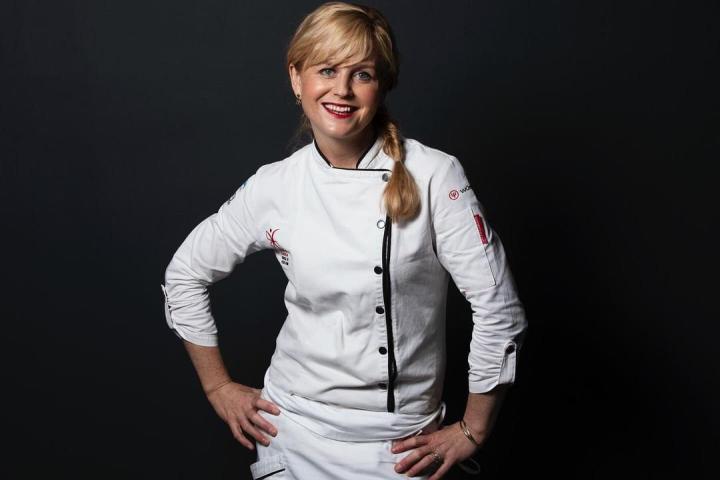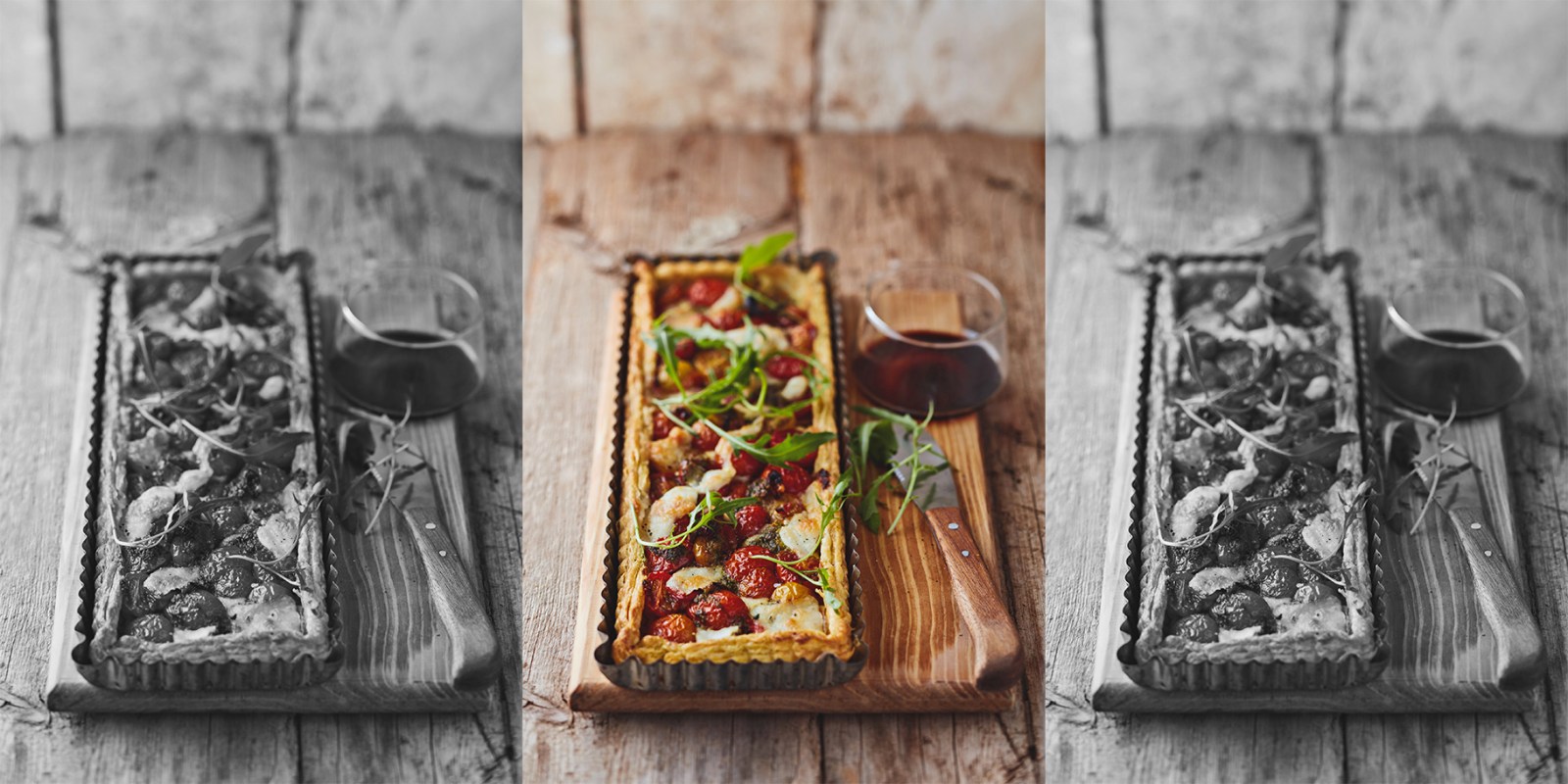COOK WITH THE CHEFS
Chef Jackie Cameron is puffed up with pride for her rising stars

Chef Jackie Cameron was so keen to take part in this series that she sent us a second helping, and two portions of it: her intriguing Caprese tart, and her secret recipe for puff pastry too. It’s laborious, and it’s the real deal.
“I don’t have dropouts,” says chef and cookery school owner Jackie Cameron, with the same passion for teaching as she has for cooking her award-winning food.
And her students don’t necessarily go directly into professional kitchens. Some do, like Carla Schulze, head chef at Luke Dale Roberts’ Salon in Cape Town. Cheri Kustner is Development Chef for the La Colombe group, while Marizen Smit and Zandy Armstrong are both at Restaurant JAN in Nice.
But others find professional posts outside of restaurants. Sarah Farrington is a personal chef who catered for Tom Cruise during the filming of Mission Impossible: Dead Reckoning. Jordin Shelley is a chocolatier in her own business, Cocoa Africa. Georg Lens is satisfying his travel bug by cooking on super yachts. Connor Benn owns The Tipsy Cup, creating alcohol-infused ice cream.
“They’re here, there and everywhere around the world,” Cameron says of the students of her Jackie Cameron School of Food & Wine that she opened in 2015. And she doesn’t take her hand off, but keeps an eye on them as they move into the industry.
Her students will all, by now, be very familiar with how to make their own puff pastry, and this savoury tart is to be made with it.
Jackie says homemade pesto is “so much nicer than bought. When basil is in season, double or treble the quantities and make enough to store. It keeps well in a sterilised airtight container in the fridge.”
She adds that lightly toasting the pine nuts beforehand “adds a lovely roasted flavour to the pesto. Spread on a baking tray and place in a 160°C oven for 10 minutes, or place in a heavy-based pan and toss over a gentle heat. Do not allow the nuts to burn. Flaked almonds are a more reasonably priced alternative to pine nuts, and just as delicious.”
Jackie Cameron’s puff pastry Caprese tart

Jackie Cameron’s puff pastry Caprese tart – and how to master puff pastry. (Photo: Myburgh du Plessis)
(Makes 1 tart)
For the puff pastry case:
400 g puff pastry (recipe below)
Basil pesto:
35 g fresh basil
30 g salted butter
125 ml olive oil
2–3 cloves garlic
50 g Parmesan or pecorino cheese, finely grated
50 g pine nuts (pine kernels) or flaked almonds
Salt and freshly ground black pepper, to taste
For the Caprese tart:
10 ml salted butter
24 cherry tomatoes, halved
pinch flaked salt
2 sprigs fresh rosemary, finely chopped
splash balsamic vinegar
20–30 thin slices mozzarella cheese
40 ml basil pesto
4 sundried tomatoes, soaked in boiling water and sliced
2 buffalo mozzarella balls, torn into bite-sized pieces
To serve:
Fresh basil or rocket leaves
Olive oil
Balsamic vinegar
Salt and freshly ground black pepper, to taste
Method
Puff pastry case:
Grease a 12 × 34 cm rectangular tart tin. Roll the pastry to fit the tin and press it in gently to cover the base and sides. Prick well with a fork. Place into the fridge for at least 30 minutes, to rest.
Blind-bake the pastry case in a preheated oven at 200ºC for about 20 minutes, or until cooked. Set aside to cool before adding the filling.
Basil pesto:
Place the basil, butter, olive oil, garlic and grated cheese into a blender or processor and pulse to combine.
Add the nuts and pulse until the correct consistency is reached.
Season to taste with salt and pepper.
Caprese tart:
Heat a frying pan very well. Add the butter and when it starts to sizzle, add the halved cherry tomatoes. Season with the salt, rosemary and a splash of balsamic vinegar and cook until the tomatoes are just soft, but still holding their shape. Remove from the heat.
Line the base of the pastry case with the thin slices of mozzarella cheese.
Pour over the cooked cherry tomatoes.
Drizzle with the basil pesto and scatter over the sliced sundried tomatoes.
Top with the torn buffalo mozzarella.
Place the tart tin on a baking tray and bake in a preheated oven at 220°C for 10–15 minutes, then pop it under the grill for 5 minutes, until the mozzarella is bubbling and golden.
To serve:
Remove the warm tart from the tin and place on a bed of fresh basil or rocket leaves. Drizzle over some olive oil and balsamic vinegar and garnish with salt and black pepper.
Puff pastry
Puff pastry is time-consuming to make, says Cameron, but the homemade version is infinitely better than anything you can buy.
You’ll need to set aside most of a day to allow for all the resting time in between the rolling and folding, but a big plus is that puff pastry freezes well; just make sure you defrost it thoroughly (overnight, in the fridge) before using.
This recipe makes more pastry than is required for any of the recipes, so you’ll definitely have enough for a second or even a third dish.
(Makes ± 1.2 kg puff pastry)
Ingredients
For preparing the butter
450 g salted butter, at room temperature, grated
115 g white bread flour
15 ml freshly squeezed lemon juice
For making the dough
200 g cake flour
200 g white bread flour
50 g cold salted butter, cut into small blocks
250 ml iced water
15 ml freshly squeezed lemon juice
5 ml fine salt
Method
Preparing the butter:
Combine all the ingredients in a mixing bowl, working the flour into the butter with a wooden spoon or your hands.
Turn the mixture out onto a work surface and shape into a block (± 10 x 10 cm).
Wrap tightly in clingfilm and place in the fridge until the butter is chilled and firm, but not hard. (You can do this ahead of time, but remember to take the butter mixture out of the fridge a few minutes before you need it, so it is not rock-hard.)
Making the dough:
Sift the cake flour and white bread flour together.
Add the blocks of butter, working them in with your fingertips until the texture resembles breadcrumbs.
Make a well in the centre of the flour mixture and pour in the iced water, lemon juice and salt.
Using your fingers, work the ingredients into a dough, trying to knead as little as possible. Shape the dough into a ball, wrap tightly in clingfilm, and place in the fridge for an hour or two, until firm and cold.
Making the pastry:
Take the ball of chilled dough out of the fridge. Remove the clingfilm. Flatten the dough slightly and score an “X” on top. Roll out the four “arms” of the cross, making sure the centre of the dough is about four times thicker than the arms, and about the same size as the butter-flour block resting in the fridge.
Place the chilled butter-flour block in the centre of the dough (if it doesn’t fit, roll the dough out some more). Fold each arm of dough in turn back over the butter, to enclose it, pressing down lightly to make a snug fit.
Flour your working surface well. Roll the dough into a rectangle (roll up and down only, keeping to the same direction). Lightly mark the rectangle into horizontal thirds. Fold the bottom third of the dough upwards and fold the top third down to meet the lower edge (as if making an envelope).
Give the dough a quarter turn, so the closed side is on the left (like the spine of a book). This completes one fold. Mark the edge with a single finger indentation (this will remind you how many “fold-and-turn” steps you have completed). Wrap the dough tightly in clingfilm and place it in the fridge to rest for at least 30 minutes, or until cold.
Repeat the rolling, folding and resting process five more times (for a total of six “folds”), marking the appropriate number of finger indentations on each fold, to help you keep track. After the final 30-minute resting period, the pastry is ready to be used in a recipe.
At this point, you can leave the pastry in the fridge overnight, or even for a few days. If you only need a portion of the pastry for a recipe, divide it and freeze whatever you don’t need. Remember to defrost frozen pastry thoroughly before using in a recipe, preferably overnight in the fridge.
Bread flour was used in this puff pastry because it provides the gluten structure needed to form a strong dough that is able to trap the water vapour that forms during the baking process. DM





Comments - Please login in order to comment.